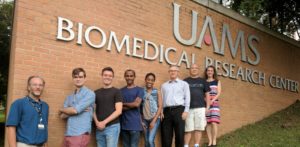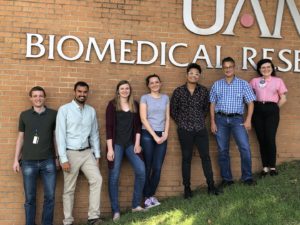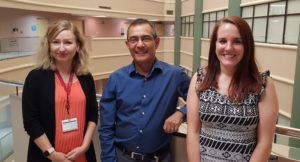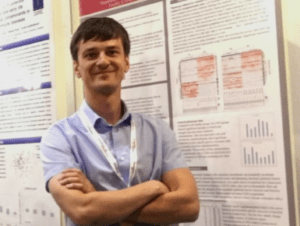Congratulations to Dr. Alijca Urbaniak, Instructor in the Department of Biochemistry and Molecular Biology, on receiving research funding of $25,000 from the Barton Pilot Grant Program. This award is for one (1) calendar year to fund additional research related to Dr. Urbaniak’s grant entitled “Novel Monensin Analogs for the Treatment of Metastatic Breast Cancer”.
Department News
Oleg Karaduta & Mari Davidson invited as Guest Editors
Dr. Oleg Karaduta and Dr. Mari Davidson invite contributions to a special issue of applied sciences on the Evolution of Modern Molecular Biology Applications.
Forty years ago, when relatively powerful microprocessors first became available, many young entrepreneurs were inspired to create companies, platforms, and programming tools that helped make computing available to everyone. This in turn helped spark the information revolution. Today, thanks to the increasing sophistication, speed, and power of computer modeling and other new tools, we are on the brink of another revolution — this time in bioscience.
The aim of this Special Issue, therefore, is to offer a platform for scientists working on the different aspects of Molecular Biology; fusion of classical methods with novel approaches drives human progress, and it is this belief that fuels our optimism in that direction.
We invite you to submit manuscripts addressing novel uses of classical techniques in molecular biology and possible applications of these methods in future medical and life science research for a compilation of our current knowledge into a comprehensive issue.
Congratulations Dr. Taylor!
Congratulations to Erin Taylor who successfully defended her Ph.D. dissertation entitled “Immune Modulation Response to Checkpoint Inhibition in Metastatic Melanoma” on December 1st. Erin was a student in the laboratory of Dr. Alan Tackett.
November publications
Toxicol Lett.
 Identifying RNA Helicase Inhibitors Using Duplex Unwinding Assays.
Identifying RNA Helicase Inhibitors Using Duplex Unwinding Assays.
Congratulations Dr. Koss!
Congratulations to Brian Koss who successfully defended his Ph.D. dissertation entitled “Epigenetic control of Cdkn2a.Arf protects tumor-infiltrating lymphocytes from exhaustion” on November 18th. Brian was a student in the laboratory of Dr. Alan Tackett and is now a post-doctoral fellow in the Center for Translational Pediatric Research as part of the Proteomics Technology Development Shared Resource under the direction of Dr. Rick Edmondson. A summary of his research is below.
T cell exhaustion in cancer is linked to poor clinical outcomes and evidence suggests T cell metabolic changes precede functional exhaustion. Direct competition between tumor-infiltrating lymphocytes (TILs) and cancer cells for metabolic resources often renders T cells dysfunctional. Here, we report an epigenetic mechanism contributing to the development of metabolic exhaustion in TILs. Environmental stress produces epigenome remodeling events within tumor-infiltrating lymphocytes resulting from loss of the histone methyltransferase EZH2. Using a multi-omics approach, we have defined an ARF-mediated, p53-independent mechanism by which EZH2 inhibition leads to mitochondrial dysfunction and the resultant exhaustion. Reprogramming T cells to express a gain-of-function EZH2 mutant resulted in an enhanced ability of T cells to inhibit tumor growth. Our data suggest manipulation of T cell EZH2 within the context of cellular therapies may yield lymphocytes which are able to withstand harsh tumor metabolic environments and collateral pharmacologic insults.
Grad School Informational Webinar
Thinking about graduate school in the biomedical sciences?
Join us on Thursday November 9, 2020 for a free online event where our current students will share their experiences in the UAMS Graduate Program in Interdisciplinary Sciences (GPIBS) Biochemistry Track.
Programmatic details & the application process will also be discussed.

Alicja Urbaniak appointed to JBMT editorial board
Congratulations to Dr. Alicja Urbaniak who has been appointed to the Editorial Advisory Board of the Journal of Biochemical and Molecular Toxicology (JBMT).
Five UAMS Researchers Receive Seed Funding for New Projects
Five UAMS scientists were awarded $15,000 each to fund research projects in the coming year, thanks to an endowment created by generous donors nearly four decades ago.
The Medical Research Endowment Fund was one of the first major fundraising campaigns of the UAMS Board of Advisors. Established in 1982 to stimulate and support research programs of UAMS faculty, the fund has received financial contributions from individuals, corporations and foundations. It’s a way for donors to make an immediate impact in valuable research at the ground level.
The awards are a vital bridge between the researchers’ initial ideas and major discoveries. By providing seed funding for research, individual researchers or teams can collect preliminary data and form hypotheses before seeking major research grants.
The grant awards provide seed funding for research that has the potential to develop into scientifically significant research projects. Grants support new areas of research for junior investigators and new lines of investigation for established faculty. Awards are made annually in early fall, with funds becoming available to each investigator in January. MRE funds provide for equipment, operating expenses and consultation costs for 12 months.
The grant awardees and their projects are:
- Alicia Byrd, Ph.D., assistant professor, Department of Biochemistry and Molecular Biology, College of Medicine; The Role of DNA Helicase B in Response to DNA Replication Stress
- Rupak Pathak, Ph.D., assistant professor, Division of Radiation Health, Department of Pharmaceutical Sciences, College of Pharmacy; Improving Efficacy and Safety of Prostate Cancer Radiotherapy with Mevalonate Pathway Inhibitors
- Youssef Aachoui, Ph.D., assistant professor, Department of Microbiology and Immunology, College of Medicine; Host-Pathogen Interplay Between Shigella and the Inflammasome
- Behjatolah “BJ” Karbassi, Ph.D., assistant professor, Department of Pathology, College of Medicine; Defining Tumor-Associated Glycans on Breast Cancer Cells that are Ligands for Macrophage SR-A
- Merideth Addicott, Ph.D., assistant professor, Department of Psychology, College of Medicine; Validating Electronic Nicotine Delivery System (END) Self-Reports Using Biochemical and Topographical Measures
Because of the generosity of donors who continue to support UAMS’ pioneering research efforts and the Medical Research Support Endowment Fund, hundreds of investigators have received funding totaling more than $3.1 million since the awards’ inception in 1982. Their return on investment has been significant, generating tens of millions of dollars in extramural funding.
October Publications
 Significance of Competing Metabolic Pathways for 5F-APINACA Based on Quantitative Kinetics.
Significance of Competing Metabolic Pathways for 5F-APINACA Based on Quantitative Kinetics.
September publications

Taylor EM, Byrum SD, Edmondson JL, Wardell CP, Griffin BG, Shalin SC, Gokden M, Makhoul I, Tackett AJ, Rodriguez A.
Acta Neuropathol Commun.
 DNA-PKcs Inhibition Extends Allogeneic Skin Graft Survival.
DNA-PKcs Inhibition Extends Allogeneic Skin Graft Survival.




